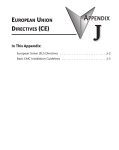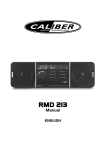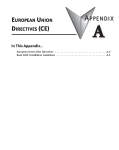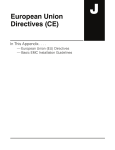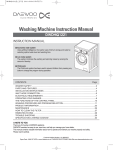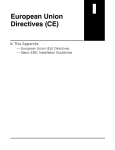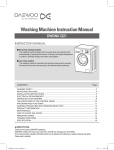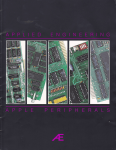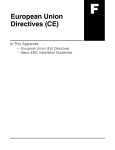Download Appendix A - AutomationDirect
Transcript
EUROPEAN UNION DIRECTIVES (CE) A PPENDIX PPENDIX A In This Appendix... European Union (EU) Directives . . . . . . . . . . . . . . . . . . . . . . . . . . . .A-2 Basic EMC Installation Guidelines . . . . . . . . . . . . . . . . . . . . . . . . . . .A-4 Appendix A: European Union Directives (CE) A 2 3 4 5 6 7 8 9 10 11 12 13 14 A B C D European Union (EU) Directives NOTE: The information contained in this section is intended as a guideline and is based on our interpretation of the various standards and requirements. Since the actual standards are issued by other parties, and in some cases governmental agencies, the requirements can change over time without advance warning or notice. Changes or additions to the standards can possibly invalidate any part of the information provided in this section. This area of certification and approval is absolutely vital to anyone who wants to do business in Europe. One of the key tasks that faced the EU member countries and the European Economic Area (EEA) was the requirement to bring several similar yet distinct standards together into one common standard for all members. The primary purpose of a single standard was to make it easier to sell and transport goods between the various countries and to maintain a safe working and living environment. The Directives that resulted from this merging of standards are now legal requirements for doing business in Europe. Products that meet these Directives are required to have a CE mark to signify compliance. Member Countries As of January 1, 2007, the members of the EU are Austria, Belgium, Bulgaria, Cyprus, Czech Republic, Denmark, Estonia, Finland, France, Germany, Greece, Hungary, Ireland, Italy, Latvia, Lithonia, Luxembourg, Malta, Netherlands, Poland, Portugal, Romania, Slovakia, Slovenia, Spain, Sweden, and United Kingdom. Iceland, Liechtenstein, and Norway together with the EU members make up the European Economic Area (EEA) and all are covered by the Directives. Applicable Directives There are several Directives that apply to our products. Directives may be amended, or added, as required. • Electromagnetic Compatibility Directive (EMC) — this Directive attempts to ensure that devices, equipment, and systems have the ability to function satisfactorily in an electromagnetic environment without introducing intolerable electromagnetic disturbance to anything in that environment. • Machinery Safety Directive — this Directive covers the safety aspects of the equipment, installation, etc. There are several areas involved, including testing standards covering both electrical noise immunity and noise generation. • Low Voltage Directive — this Directive is also safety related and covers electrical equipment that has voltage ranges of 50–1000VAC and/or 75–1500VDC. • Battery Directive — this Directive covers the production, recycling, and disposal of batteries. Compliance Certain standards within each Directive already require mandatory compliance. The EMC Directive, which has gained the most attention, became mandatory as of January 1, 1996. The Low Voltage Directive became mandatory as of January 1, 1997. Ultimately, we are all responsible for our various pieces of the puzzle. As manufacturers, we must test our products and document any test results and/or installation procedures that are necessary to comply with the Directives. As a machine builder, you are responsible for A–2 Hardware User Manual, 4th Edition, Rev. B Appendix A: European Union Directives (CE) installing the products in a manner which will ensure compliance is maintained. You are also responsible for testing any combinations of products that may (or may not) comply with the Directives when used together. The end user of the products must comply with any Directives that may cover maintenance, disposal, etc. of equipment or various components. Although we strive to provide the best assistance available, it is impossible for us to test all possible configurations of our products with respect to any specific Directive. Because of this, it is ultimately your responsibility to ensure that your machinery (as a whole) complies with these Directives and to keep up with applicable Directives and/or practices that are required for compliance. Productivity3000 systems manufactured by Koyo Electronics Industries or FACTS Engineering, when properly installed and used, conform to the Electromagnetic Compatibility (EMC), Low Voltage Directive, and Machinery Directive requirements of the following standards. • Product Specific Standard for Programmable Controllers EN61131–2:2003 Programmable controllers, equipment requirements and tests. This is the product specific standard for PACs and covers the low voltage and EMC directives as required for European CE certification. This standard has many tests together with test procedures and limits, but also references the below standards for some tests: IEC 60068-2-1:1990 part 2 tests A, 60068-2-2:1974 part 2 test B, IEC 60068-2-6:1995, Part 2: Test Fc, IEC 60068-2-14:1984 Part 2 Test N, IEC 60068-2-27:1987 Part 2 Test Ea, IEC 60068-230:1980, Part 2 Test Db, IEC 60068-2-31:1969 Part Test Ec, IEC 60068-2-32:1975 Part 2 Test Ed, IEC 60417 (all parts), IEC 60664-1:1992 Part 1, IEC 60664-3:1992, IEC 60695-2-1 (all sheets), Part 2: IEC 60707:1999 IEC 60947-5-1:1997 Part 5-1 IEC 60947-7-1:2002 Part 7-1, I EC 609501:2001 Part 1, IEC 61000-4-2:1995, Part 4-2, IEC 61000-4-3:2002 Part 4-3, IEC 61000-4-4:1995, IEC 61000-4-5:1995 Part 4-5, IEC 61000-4-6:1996, Part 4-6, IEC 61000-4-8:1993 Part 4-8, IEC 61000-4-12:1995 Part 4-12, IEC 61010-1:2001 Part 1, CISPR 11:1999, CISPR 16-1:1999 Part 1, CISPR 16-2:1999 Part 2 For undated references, the latest edition of the referenced document (including any amendments) applies. • Warning on Electrostatic Discharge (ESD) We recommend that all personnel take necessay precautions to avoid the risk of transferring static charges to inside the control cabinet, and clear warnings and instructions should be provided on the cabinet exterior. Such precautions may include the use of earth straps, grounding mats and similar static-control devices, or the powering off of the equipment inside the enclosure before the door is opened. • Warning on Radio Interference (RFI) This is a class A product. In a domestic environment this product may cause radio interference in which case the user may be required to take adequate measures. General Safety • External switches, circuit breaker or external fusing, are required for these devices. • The switch or circuit breaker should be mounted near the programmable controller equipment. Hardware User Manual, 4th Edition, Rev. B A–3 A 2 3 4 5 6 7 8 9 10 11 12 13 14 A B C D Appendix A: European Union Directives (CE) Special Installation Manual The installation requirements to comply with the requirements of the Machinery Directive, A EMC Directive and Low Voltage Directive are slightly more complex than the normal installation requirements found in the United States. To help with this, we have published a special manual which you can order or download from our website: 2 • DA–EU–M – EU Installation Manual that covers special installation requirements to meet the EU Directive requirements. Refer to this manual for updated information. 3 Other Sources of Information Although the EMC Directive gets the most attention, other basic Directives, such as the 4 Machinery Directive and the Low Voltage Directive, also place restrictions on the control panel builder. Because of these additional requirements it is recommended that the following 5 publications be purchased and used as guidelines: • BSI publication TH 42073: February 1996 – covers the safety and electrical aspects of the 6 Machinery Directive • EN 60204–1:1992 – General electrical requirements for machinery, including Low Voltage and EMC considerations 7 • IEC 1000–5–2: EMC earthing and cabling requirements • IEC 1000–5–1: EMC general considerations 8 It may be possible for you to obtain this information locally; however, the official source of applicable Directives and related standards is: 9 The Office for Official Publications of the European Communities L–2985 Luxembourg; quickest contact is via the web at http://publications.europa.eu 10 Another source is: British Standards Institution – Sales Department 11 Linford Wood Milton Keynes 12 MK14 6LE 13 United Kingdom; the quickest contact is via the web at www.bsigroup.com 14 Basic EMC Installation Guidelines Enclosures A The simplest way to meet the safety requirements of the Machinery and Low Voltage Directives is to house all control equipment in an industry standard lockable steel enclosure. B This normally has an added benefit because it will also help to reduce EMC emissions. Although the RF emissions from the programmable controller equipment, when measured in the open air, are well below the EMC Directive limits, certain configurations can increase C emission levels. Holes in the enclosure, for the passage of cables or to mount operator interfaces, can increase emissions. D A–4 Hardware User Manual, 4th Edition, Rev. B Appendix A: European Union Directives (CE) Mains Filters Productivity3000 AC powered base power supplies do not require extra mains filtering to comply with the EMC Directive on conducted RF emissions. DC powered base power supplies require a mains filter. A CORCOM 6MV1 filter was tested and reduced emissions to an acceptable level. Suppression and Fusing In order to comply with the fire risk requirements of the Low Voltage and Machinery Directive standards EN 61010–1 and EN 60204–1, it is necessary to fuse both sides of the power inputs (on both AC and DC units). Transient suppressors must be protected by fuses and the capacity of the transient suppressor must be greater than the blow characteristics of the fuses or circuit breakers to avoid a fire risk. A recommended AC supply input arrangement for the Productivity 3000 is to use twin 3 amp TT fused terminals with fuse blown indication, such as DINnectors DN–F10L terminals, or twin circuit breakers. Internal Enclosure Grounding A heavy-duty star earth terminal block should be provided in every cubicle for the connection of all earth ground straps, protective earth ground connections, mains filter earth ground wires, and mechanical assembly earth ground connections. This should be installed to comply with safety and EMC requirements, local standards, and the requirements found in IEC 1000–5–2. The Machinery Directive also requires that the common terminals of the programmable controller input modules, and common supply side of loads driven from programmable controller output modules should be connected to the protective earth ground terminal. Key Serial Communication Cable Equi-potential Bond Equi–potential Grounding Adequate site earth grounding must be provided for equipment containing modern electronic circuitry. The use of isolated earth electrodes for electronic systems is forbidden in some countries. Make sure you check any requirements for your particular destination. IEC 1000–5–2 covers equi-potential bonding of earth grids adequately, but special attention should be given to apparatus and control cubicles that contain I/O devices, remote I/O racks, or have inter-system communications with the primary PAC system enclosure. An equipotential bond wire must be provided alongside all serial communications cables, and to any separate items of the plant which contain I/O devices connected to the programmable controller. The diagram shows an example of four physical locations connected by a communications cable. Hardware User Manual, 4th Edition, Rev. B A–5 A 2 3 4 5 6 7 8 9 10 11 12 13 14 A B C D Appendix A: European Union Directives (CE) Communications and Shielded Cables A 2 3 4 5 6 7 8 9 10 11 12 13 14 A B C D Screened Cable Conductive Adapter Serial I/O To Earth Block Equi-potential Bond Control Cubicle Good quality 24 AWG minimum twisted-pair shielded cables, with overall foil and braid shields are recommended for analog cabling and communications cabling outside of the programmable controller enclosure. To date it has been a common practice to only provide an earth ground for one end of the cable shield in order to minimize the risk of noise caused by earth ground loop currents between apparatus. The procedure of only grounding one end, which primarily originated as a result of trying to reduce hum in audio systems, is no longer applicable to the complex industrial environment. Shielded cables are also efficient emitters of RF noise from the PAC system, and can interact in a parasitic manner in networks and between multiple sources of interference. The recommendation is to use shielded cables as electrostatic “pipes” between apparatus and systems, and to run heavy gauge equi-potential bond wires alongside all shielded cables. When a shielded cable runs through the metallic wall of an enclosure or machine, it is recommended in IEC 1000–5–2 that the shield should be connected over its full perimeter to the wall, preferably using a conducting adapter, and not via a pigtail wire connection to an earth ground bolt. Shields must be connected to every enclosure wall or machine cover that they pass through. A–6 Hardware User Manual, 4th Edition, Rev. B Appendix A: European Union Directives (CE) Analog and RS232 Cables Providing an earth ground for both ends of the shield for analog circuits provides the perfect electrical environment for the twisted pair cable as the loop consists of signal and return, in a perfectly balanced circuit arrangement, with connection to the common of the input circuitry made at the module terminals. RS232 cables are handled in the same way. Last Slave TXD 0V RXD + – + – 100 ⏲ Slave n Master TXD 0V RXD + – + – RXD 0V TXD + – + – 100 ⏲ 100 ⏲ Termination Termination Multidrop Cables RS422 twin twisted pair, and RS485 single twisted pair cables also require a 0V link, which has often been provided in the past by the cable shield. It is now recommended that you use triple twisted pair cabling for RS422 links, and twin twisted pair cable for RS485 links. This is because the extra pair can be used as the 0V inter-system link. With loop DC power supplies earth grounded in both systems, earth loops are created in this manner via the intersystem 0v link. The installation guides encourage earth loops, which are maintained at a low impedance by using heavy equi-potential bond wires. To account for non–European installations using single-end earth grounds, and sites with far from ideal earth ground characteristics, we recommend the addition of 100 ohm resistors at each 0V link connection in network and communications cables. Shielded Cables Within Enclosures When you run cables between programmable controller items within an enclosure which also contains susceptible electronic equipment from other manufacturers, remember that these cables may be a source of RF emissions. There are ways to minimize this risk. Standard data cables connecting PACs and/or operator interfaces should be routed well away from other equipment and their associated cabling. You can make special serial cables where the cable shield is connected to the enclosure’s earth ground at both ends, the same way as external cables are connected. Analog Modules and RF Interference The readings from all analog modules will be affected by the use of devices that exhibit high field strengths, such as mobile phones and motor drives. All AutomationDirect products are tested to withstand field strength levels up to 10V/m, which is the maximum required by the relevant EU standards. While all products passs this test, analog modules will typically exhibit deviations of their readings. This is quite normal, however, systems designers should be aware of this and plan accordingly. When assembling a control system using analog modules, these issues must be adhered to and should be integrated into the system design. This is the responsibility of the system builder/commissioner. Hardware User Manual, 4th Edition, Rev. B A–7 A 2 3 4 5 6 7 8 9 10 11 12 13 14 A B C D Appendix A: European Union Directives (CE) Network Isolation For safety reasons, it is a specific requirement of the Machinery Directive that a keyswitch must be provided that isolates any network input signal during maintenance, so that remote commands cannot be received that could result in the operation of the machinery. To avoid the introduction of noise into the system, any keyswitch assembly should be housed in its own earth grounded steel box and the integrity of the shielded cable must be maintained. Again, for further information on EU directives we recommend that you get a copy of our EU Installation Manual (DA–EU–M). Also, you can check the EU Commision’s official web site at: http://publications.europa.eu. It is good Engineering practice to install toroid inductors on the I/O wiring and the communications cables such as listed in the table below. A 2 3 4 5 6 7 8 9 10 11 12 13 14 A B C D Toroid Inductors Manufacturer RS Online Fair-Rite Wurth Elektronick Mfg. Part Number Outside Diameter Inside Diameter Length 260–6795 17.5 mm 9.5 mm 28.5 mm 2643665702 17.5 mm 9.5 mm 28.5 mm 742 700 9 17.5 mm 9.5 mm 28.5 mm Metallic conduit required A–8 Hardware User Manual, 4th Edition, Rev. B Appendix A: European Union Directives (CE) Items Specific to the Productivity3000 • The rating between all circuits in this product are rated as basic insulation only, as appropriate for single fault conditions. • It is the responsibility of the system designer to earth one side of all control and power circuits, and to earth the braid of screened cables. • This equipment must be properly installed while adhering to the guidelines of the in house PAC installation manual DA–EU–M, and the installation standards IEC 1000–5–1, IEC 1000–5–2 and IEC 1131–4. • It is a requirement that all PLC equipment must be housed in a protective steel enclosure, which limits access to operators by a lock and power breaker. If access is required by operators or untrained personnel, the equipment must be installed inside an internal cover or secondary enclosure. • It should be noted that the safety requirements of the machinery directive standard EN60204–1 state that all equipment power circuits must be wired through isolation transformers or isolating power supplies, and that one side of all AC or DC control circuits must be earthed. • Both power input connections to the programmable controller must be separately fused using 3 amp T type anti–surge fuses, and a transient suppressor fitted to limit supply overvoltages. • If the equipment is used in a manner not specified by the manufacturer the protection provided by the equipment may be impaired. Hardware User Manual, 4th Edition, Rev. B A–9 A 2 3 4 5 6 7 8 9 10 11 12 13 14 A B C D Appendix A: European Union Directives (CE) Notes A 2 3 4 5 6 7 8 9 10 11 12 13 14 A B C D A–10 Hardware User Manual, 4th Edition, Rev. B










